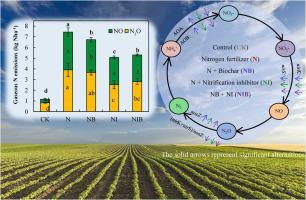当前位置:
X-MOL 学术
›
Agric. Ecosyst. Environ.
›
论文详情
Our official English website, www.x-mol.net, welcomes your
feedback! (Note: you will need to create a separate account there.)
Enhanced mitigation of N2O and NO emissions through co-application of biochar with nitrapyrin in an intensive tropical vegetable field
Agriculture, Ecosystems & Environment ( IF 6.0 ) Pub Date : 2024-02-01 , DOI: 10.1016/j.agee.2024.108910
Changhua Fan , Youfeng Leng , Xiaotong Wang , Junjiao Wang , Yajun Fu , Xiaomin Huang , Wenlong Gao , Wen Zhang , Huiran Liu , Ziyu Ning , Qinfen Li , Miao Chen
Agriculture, Ecosystems & Environment ( IF 6.0 ) Pub Date : 2024-02-01 , DOI: 10.1016/j.agee.2024.108910
Changhua Fan , Youfeng Leng , Xiaotong Wang , Junjiao Wang , Yajun Fu , Xiaomin Huang , Wenlong Gao , Wen Zhang , Huiran Liu , Ziyu Ning , Qinfen Li , Miao Chen

|
Vegetable fields in tropical regions characterized by intensive cultivation have the potential to be significant sources of gaseous nitrogen (N) emissions. This is primarily due to human-induced input of N fertilizer and the naturally abundant water and heat resources in these areas. While biochar and nitrification inhibitors are recognized as effective measures for mitigating soil nitrous oxide (NO) and nitric oxide (NO) emissions, there is limited research on their combined effectiveness in intensively managed tropical croplands. In a 2-year field experiment conducted in a tropical vegetable ecosystem, we investigated the impact of single and combined applications of peanut biochar and nitrapyrin (a nitrification inhibitor) on NO and NO emissions, N-cycling associated gene abundances, and bacterial community structure. Under conventional fertilization, cumulative NO and NO emissions were 1.96 kg N ha yr and 1.76 kg N ha yr, with emission factors of N fertilizer for NO (EF) and NO (EF) at 0.29% and 0.30%, respectively. The random forest model indicated that soil organic carbon (SOC) was key in regulating NO+NO emissions. Biochar alone decreased cumulative NO and NO emissions by 6.1 % and 13.0 %, respectively. When biochar was co-applied with nitrapyrin, the mitigation of NO and NO reached up to 23.4 % and 18.6 %, respectively. This enhanced effect was attributed to the strong inhibitory impact of nitrapyrin on nitrifiers (AOA and AOB) and denitrifiers (/) in biochar-amended soils. Additionally, biochar co-application increased SOC levels in nitrapyrin-applied soils. Analysis of bacterial community structure revealed that nitrapyrin decreased the relative abundance of , while biochar increased the relative abundance of , , and to varying extents. Considering the carbon sequestration ability of biochar and the effective mitigation potential of nitrapyrin, the combined application of biochar with a nitrification inhibitor emerges as a promising strategy for dual objectives - reducing gaseous N emissions and enhancing soil carbon storage - in intensive vegetable ecosystems in the tropical region of China.
更新日期:2024-02-01































 京公网安备 11010802027423号
京公网安备 11010802027423号